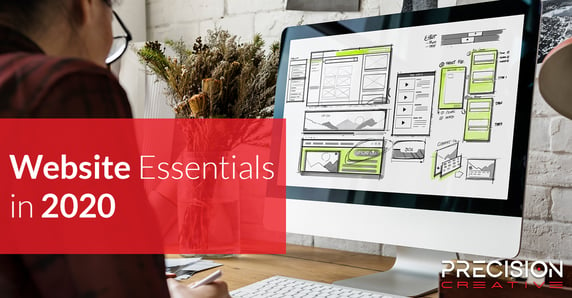Top 4 Priorities for Today’s Websites
A website can be anything from an advertisement to a virtual location. Whether you run a large online business or simply need a digital presence for your customers, these four priorities will help you succeed in the modern environment.
1. User Experience
User experience refers to the way audiences interact and engage with your site. This design philosophy encompasses everything from layout to accessibility and is focused on making your site enjoyable, informative, and easy-to-use.
To understand user experience, simply pretend you’re in the customer’s shoes - or in this case, sitting behind the customer’s screen. What do they see when they visit your site? How easy is it to find what they’re looking for? Do the features of your layout contribute to a better shopping experience?
A great website is built with user experience in mind from the very beginning. Designers create layouts that visually attractive and easy to navigate, developers implement features that are functional and easy to use, and copywriters create informative content that helps the reader understand each page.
Even long-standing websites can usually benefit from a user experience review. Sometimes, adding a page or changing a menu can dramatically improve the user journey and turn confused visitors into paying and returning customers.
2. eCommerce Capability
Modern customers want to do business online. Whether it’s booking an appointment or buying physical products, you should strive to make all of your services accessible from a computer or mobile device.
For retailers, this usually means transitioning to a digital storefront, complete with an online inventory and a digital checkout process. If you already have an online store, you should make sure that it functions smoothly and shows your products in the best possible light.
Other company models can also use eCommerce tools to make business more convenient for their customer base. You can add an appointment calendar, start accepting digital payments, or even use a live chat system to answer immediate questions. User portals can help customers share files, save information, and remain engaged with a project from wherever they happen to be.
As work-from-home progresses, expect to see more innovative uses of eCommerce technology from the companies you love. Now’s a great time to think about how your services can benefit from digital integration; even when you’re back in the office, many of your clients will still be online.
3. Relevant Content
Content serves a variety of purposes on a professional website. It can explain your business to users and search engines, define your company voice and brand identity, or attract new audiences.
When you first build a site, you need great content to fill out each of the pages. Customers want to know who you are, why you’re in business, and what services you provide. This content also doubles as a way for search engines to understand and index your site.
Content is also an important part of an inbound marketing strategy. Audiences are attracted to valuable content that informs or entertains. If you publish high-quality content that’s relevant to your industry, you’ll naturally draw in traffic from people who are interested in the services you provide.
A modern website can’t function without content, so it’s important to make sure yours is on point. From adding product descriptions to blogging about industry news, you might be surprised at how a little extra text improves both your site traffic and your conversion rate.
4. Strong Calls-to-Action
The call-to-action is the defining feature of any successful marketing strategy. You can run ads, polish your website, and develop your social media presence as much as you like; but if you don’t have a CTA, your customers might not actually know how to buy into your campaign.
A call-to-action tells the customer what you want them to do. In advertisements, this is often as simple as “click here” or “look at this product.” On a website, a CTA is more likely to sound like “contact us” or “join our mailing list.” Even on social media, most successful accounts ask their users to “like,” “comment,” or “subscribe.”
CTAs work best when they’re simple and direct. By the time a customer sees a call-to-action, you should have already piqued their interest or convinced them that your product is valuable. These customers are ready to convert; they’re just waiting for you to tell them how to do it.
Prioritize with Precision
Great websites are built with hard work and expertise. Get in touch with the team at Precision Creative if you want your services to reach the modern world.
